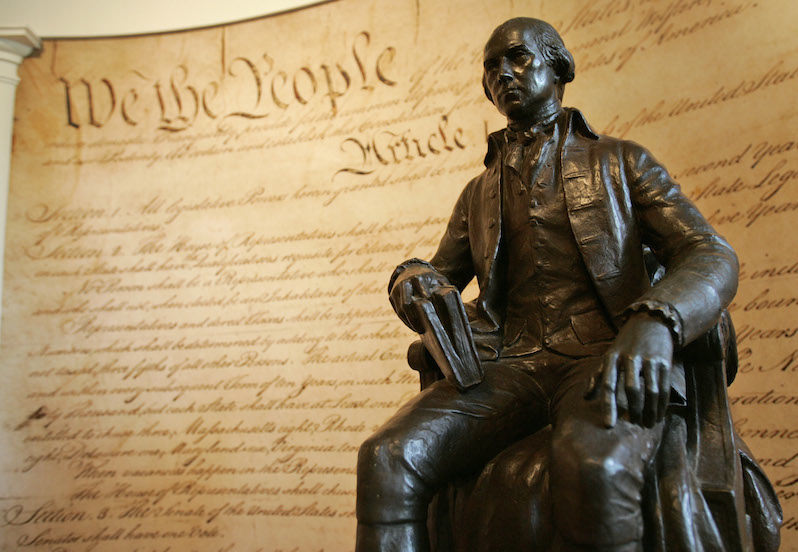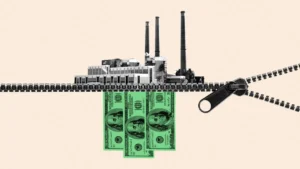Impeach the U.S. Constitution
Our charter is outdated. We need to devise a new governmental structure to protect and advance the common good in the 21st century. A statue of President James Madison at Montpelier, Madison's home in Orange, Va. (Steve Helber / AP)
A statue of President James Madison at Montpelier, Madison's home in Orange, Va. (Steve Helber / AP)
A statue of President James Madison at Montpelier, Madison’s home in Orange, Va. (Steve Helber / AP)
I am always darkly amused when I hear one of my fellow Americans call for a return from our current “deep state” plutocracy and empire to the supposedly benevolent and democratic rules and values of the nation’s sacred founders and Constitution. Democracy was the last thing the nation’s founders wanted to see break out in the new republic. Drawn from the elite propertied segments in the new republic, most of the delegates to the 1787 Constitutional Convention shared their compatriot John Jay’s view that “Those who own the country ought to govern it.”
As the celebrated U.S. historian Richard Hofstader noted in his classic 1948 text, “The American Political Tradition and the Men Who Made It”: “In their minds, liberty was linked not to democracy but to property.” Democracy was a dangerous concept to them, conferring “unchecked rule by the masses,” which was “sure to bring arbitrary redistribution of property, destroying the very essence of liberty.”
Hofstader’s take on the founders was borne out in historian Jennifer Nedelsky’s comprehensively researched volume, “Private Property and the Limits of American Constitutionalism,” in 1990. For all but one of the U.S. Constitution’s framers (James Wilson), Nedelsky noted, protection of “property” (meaning the people who owned large amounts of it) was “the main object of government.” The non-affluent, non-propertied and slightly propertied popular majority was for the framers “a problem to be contained.”
Against ‘The Secret Sigh for a More Equal Distribution’
Anyone who doubts the anti-democratic character of the founders’ world view should read The Federalist Papers, written by the leading advocates of the U.S. Constitution to garner support for their preferred form of national government in 1787 and 1788. In Federalist No. 10, James Madison argued that democracies were “spectacles of turbulence … incompatible with … the rights of property.” Democratic governments gave rise, Madison felt, to “factious leaders” who could “kindle a flame” among dangerous masses for “wicked projects” like “abolition of debts” and “an equal division of property. … Extend the [geographic] sphere [of the U.S. republic],” Madison wrote, and it becomes “more difficult for all who feel it to discover their own strength and act in union with each other.”
At the Constitutional Convention, Madison backed an upper U.S. legislative assembly (the Senate) of elite property holders to check a coming “increase of population” certain to “increase the proportion of those who will labour under all the hardships of life, and secretly sigh for a more equal distribution of its blessings” [emphasis added]. “These may in time outnumber those who are placed above the feelings of indigence. According to the equal laws of suffrage, the power will slide into the hands of the former.”
In Federalist No. 35, the future first U.S. secretary of the treasury, Alexander Hamilton, argued that the common people found their proper political representatives among the small class of wealthy merchant capitalists. “The idea of an actual representation of all classes of people by persons of each class,” Hamilton wrote, “is altogether visionary.” The “weight and superior acquirements of the merchants render them more equal” than the “other classes,” Hamilton proclaimed.
Checkmating Democracy
Consistent with these sentiments, the nation’s rich white fathers crafted a form of “popular government” (their deceptive term) that was a monument to popular incapacitation. The U.S. Constitution divided the federal government into three parts, with just one-half of one of those three parts (the House of Representatives) elected directly by “the people”—a category that excluded blacks, women, Native Americans and property-less white males (that is, most people in the early republic). It set up elaborate checks and balances to prevent the possibility of the laboring multitude influencing policy. It introduced a system of intermittent, curiously time-staggered elections (two years for the House, six years for the Senate, and four years for the presidency) precisely to discourage sweeping popular electoral rebellions. It created a Supreme Court appointed for life with veto power over legislation or executive actions that might too strongly bear the imprint of the “secretly sigh[ing]” multitude. It sanctified the epic “un-freedom” and “anti-democracy” of black slavery, permitting slave states to count their disenfranchised chattel toward their congressional apportionment in the House of Representatives. The Constitution’s curious Electoral College provision guaranteed that the popular majority would not directly select the U.S. president—even on the limited basis of one vote for each propertied white male.
It is true that the Constitution’s Article V provided a mechanism technically permitting “We the People” to amend the nation’s charter. But the process for seriously amending the U.S. Constitution was and remains exceedingly difficult, short of revolutionary and civil war. As the progressive Constitution critic Daniel Lazare observes, “Moments after establishing the people as the omnipotent makers and breakers of constitutions, [the 1787 U.S. Constitution] announced that … [c]hanging so much as a comma in the Constitution would require the approval of two-thirds of each house of Congress plus three-fourths of the states. … The people did not assert their sovereignty in Philadelphia in 1787. Rather, the founders invoked it. Once they uttered the magic incantation, moreover, they hastened to put the genie back in the bottle by declaring the people all but powerless to alter their own plan of government.”
Minority Right-Wing Rule 2017
I can already hear the objection: “So what? That was 228 years ago, when the nation’s leaders still wore powdered wigs, and slavery was the law of the land. We have since developed a modern democracy based on universal suffrage—one where the principal barriers to popular governance are about money and the corrupting power that flows from its over-concentration in too few hands.”
There are at least two key problems with this seemingly commonsense critique. First, the ever-greater concentration of wealth (and hence of power) is the consequence of the capitalism that was precisely the handiwork of the very propertied elites who were protected against the “wicked” masses by the Constitution.
Second, we are still dealing on numerous levels with the purposefully authoritarian consequences of the nation’s founding charter. The Constitution is no small part of how a nation that votes primarily for a majority centrist party, the Democrats, gets strangely ruled at present by an ever more ultra-right government led by a minority party—the Republicans.
Look at the Electoral College system, designed to curb democracy and expressly crafted to elevate the power of the slave states. By giving each state an extra vote for both senators they send to Washington (no matter how small or large each state’s populations), it triples the clout of the nation’s eight smallest states and doubles that of the next six states relative to their populations.
For the fifth time in history and the second in this century, the Electoral College has installed a president who failed to win the national popular vote. Donald Trump, the biggest popular vote-loser to ever inhabit the White House, is a reckless megalomaniac, racist, sexist, militarist and malignant narcissist. He’s an ecocidal climate change denier who should not be allowed anywhere near the nation’s energy policy or its nuclear codes. It’s not for nothing that even the depressing and highly unpopular “lying neoliberal warmonger” Hillary Clinton polled 2.8 million more votes than he did last November.
The widely loathed “Orange-Tinted Beast” made it into the world’s most powerful and dangerous job thanks in no small part to the Electoral College, which renders presidential campaigning irrelevant (and close to nonexistent) in most of the nation, gives absurdly outsized weight to disproportionately white and right-leaning rural states and openly violates the core democratic principles of majority rule and one-person, one-vote.
Along with some help from the Supreme Court, the ludicrous Electoral College is also part of how popular vote-loser George W. Bush (who criminally invaded Iraq partly out of the belief that doing so was God’s will) ascended to the presidency in 2000-2001.
Thanks to Trump’s ascendancy and the Republican-run U.S. Senate’s “check and balance” refusal to let Barack Obama appoint a Supreme Court justice to fill the vacancy left by the death of Antonin Scalia, the minority, ultra-right GOP is about to re-solidify its control of a second of the nation’s top four governing institutions—the appointed-for-life Supreme Court.
Things are even crazier in the U.S. Senate, the third such institution under minority-party, right-wing control. The GOP holds a 52-48 margin in the upper chamber, even though Democratic candidates for the U.S. Senate outpolled Republican opponents by 10.5 million votes last November. Thanks in no small part to the simple and expressly anti-democratic slant that the Constitution gives—in the name of “equal suffrage for the states”—the 2 percent of Americans who live in the nation’s nine smallest states have the same amount of senatorial representation as the 51 percent who live in the nation’s nine largest states.
Wyoming, home to more than 586,000 Americans, holds senatorial parity with California, where more than 39 million Americans reside. Due to “a growing population shift from the agricultural interior to crowded corridors along the coast,” Lazare explains, “it is possible now to win the majority of the U.S. Senate with just 17.6 percent of the popular vote.”
And then there’s the House of Representatives, where the widely hated Republican Party enjoys a 47-vote majority even though it outpolled the Democrats by just over 1 percent in House races last fall.
‘You Had Your Input’
In some rich nations operating with parliamentary systems, Trump would be well understood by now to have failed to create a functioning governing coalition. Politicians and citizens would reasonably be calling for new national elections. But nobody thinks of calling for new elections in the U.S., of course. The Constitution mandates that qualified voters go to the polls to select presidents once every four years, national senators (apportioned two per state regardless of wildly different population sizes among the nation’s 50 states) once every six years, and (lower) House representatives (apportioned in accord with population but along now strictly gerrymandered geographical lines), once every two years. As George W. Bush’s White House spokesperson Dana Perino explained in March of 2008 when asked if the citizenry should have “input” on U.S. foreign policy: “You had your input. The American people have input every four years, and that’s the way our system is set up” [emphasis added].
Perino was on all-too-strong constitutional ground. So was Trump when he tweeted in response to the historic mass demonstrations that followed his inauguration: “Watched protests yesterday but was under the impression that we just had an election! Why didn’t these people vote?” Never mind that most of the marchers likely did vote or that most U.S. citizens think public opinion should matter to a president—not just as a politician once every four years but also as a policymaker every day.
The Constitution says you get to vote for a U.S. president in a voting booth for two minutes or so once every 1,460 days.
Hello, Mike Pence?
You can advocate Trump’s constitutional impeachment (by the House) and removal (by the Senate). Trump has certainly given the House numerous grounds for impeachment, but the barriers to removal are high. The two houses of Congress, the House and the Senate, are both under the control of the president’s nominal party, the Republicans, and the Republicans are determined to get everything they can from a weakened Trump when it comes to advancing their radically regressive, racist, ecocidal and arch-plutocratic agenda. It takes a two-thirds vote in the Senate to remove a president. It’s never happened (though Richard Nixon would have likely been impeached and removed had he not resigned).
But what would impeachment and removal give the nation under the “holy” Constitution but the presidency of arch-right-wing Republican Mike Pence? You think Trump is scary? Under Pence’s superficially re-legitimizing rule, the Republican agenda that most of the populace hates could sail through Washington with chilling speed. The U.S. Constitution says that impeachment in the House and conviction in the Senate makes the Christian white nationalist Mike Pence POTUS.
Another constitutional path of removal, on 25th Amendment grounds of incapacitation or incompetence, faces similar problems.
Money Is Speech: Supremes Say So
So suck it up and get back in shape for the next holy quadrennial electoral extravaganza to vote a Democrat into the White House, right? Why bother? The Democrats are every bit as corporatized and sold-out to the financial plutocracy and its military empire—to the capitalist class and system that emerged out of national development under the rule of the propertied elite the founders worked so brilliantly to protect—as the Republicans.
This is thanks in part to the outrageously outsize role that big-money campaign contributions play in determining the outcomes of the nation’s evermore absurdly expensive elections. And that role is traceable in part to the U.S. Constitution. The founders created the Supreme Court as a critical appointed-for-life check on the popular will. And in two landmark decisions, Buckley v. Valeo (1976) and Citizens United (2010), the high court has ruled that private campaign contributions are “free speech” and that there are no “constitutional” limits to be set on how much the rich and powerful can invest in the giant organized bribery project that is U.S. campaign finance. Left Electoral Dreaming
Let’s imagine that we were still somehow able to get a domestically progressive and egalitarian, social-democratic Democrat—imagine a younger, more telegenic and gutsier Bernie Sanders—into the White House. How much difference would it make? Besides the obstructionist hell he or she would catch from the corporate media and the blockage he or she would face from the currently right-wing Supreme Court, he or she would likely face steady, additional, potent “check and balance” impediments from corporate-captive Republicans and Democrats in Congress.
Along with corporate media ownership and big-money campaign-finance power (both among the outcomes of the capitalism brought to us by the propertied elite the founders/framers were so careful to safeguard from the populace), the over-representation of right-wing rural states in the U.S. Senate militates against a progressive takeover of Congress. So does the widespread systematic gerrymandering of districts in the House of Representatives.
Want to form a politically relevant and more genuinely progressive and egalitarian third party beyond the radically regressive and reactionary Republicans and the dismal, dollar-drenched Democrats? The founders’ holy charter is not on your side. It encourages winner-take-all, first-past-the-post elections tied to specific geographical district lines. There’s no provision for proportional representation to accommodate and make legislative room for third or fourth parties that are not ready to compete and win pluralities in their relevant electoral jurisdictions.
For ‘Redesigning the State’
U.S. progressives have long advocated constitutional amendments meant to more properly align U.S. politics and policy with public opinion and basic democratic values. But Article V is too steep a barrier, on purpose. Today, 13 of the nation’s 50 states can disallow constitutional changes while containing just more than 4 percent of the nation’s population.
Around the planet, constitutions do not last very long. As Zachary Elkins, Thomas Ginsburg and James Melton noted in their book, “The Endurance of National Constitutions” (2009), “The mean lifespan [of national constitutions] across the world since 1789 is 17 years. … [Since] World War I, the average lifespan of a constitution … [is] 12 years.”
The U.S. is different. Its absurdly venerated Constitution has remained in place with occasional substantive amendments for nearly 230 years.
It’s long past time to stop standing in awe of the founders’ practically deified charter. We need to devise a new governmental structure appropriate to the advance and protection of the common good in the 21st century. Serious advocates of popular sovereignty should call for—imagine—a constituent assembly dedicated to making a new governing charter that would build and empower popular democracy, not checkmate it. Lazare reasonably advocates “an extraordinary national gathering called for the purpose not of passing ordinary legislations but of redesigning the state. … Significantly, voting on the Constitution is something Americans have never been allowed to do.”
We’re free to choose what seat we want to take in the constitutional bus but not what kind of bus we ride in or where it’s going.
Other countries hold such constituent assemblies. Why shouldn’t we? “Our” Constitution is an archaic and authoritarian straitjacket. It’s patently absurd to think that a document crafted by wealthy slave-owners, merchants and other vast property holders with the explicit purpose of keeping the “wicked” popular majority at bay near the end of the 18th century can function in meaningful service to popular self-rule in the 21st (or any other) century.
We must not, however, think of a new constitution as a magic democratic bullet. As the Wales-based left-feminist commentator and critic Élise Hendrick recently wrote me:
Working on a new constitution can be a useful exercise because it helps people deliberate on what kind of society they want to have. … And given the constitutional fetishism that exists in the U.S., and has led to this anomaly where people assume that anything they regard as right and proper must be in the constitution, attacking the constitution directly and pointing out the illegitimacy at its origin and the limits it imposes on meaningful democracy probably is a necessary step. … But the actual work of dismantling the existing society and building the desired one still has to happen. And there’s a fundamental mistake in thinking that creating a new constitution would in itself solve any problems. You can have an absolutely lovely constitution, and it’s still words on paper as long as the underlying power relations remain the same.
Eighty-six years ago, the great American philosopher John Dewey observed that “politics is the shadow cast on society by big business. …” Dewey rightly prophesized that U.S. politics would stay that way for as long as power resided in “business for private profit through private control of banking, land, industry, reinforced by command of the press, press agents, and other means of publicity and propaganda.”
Ten years later, the U.S. Supreme Court Justice Louis Brandeis made the very basic and elementary observation that Americans “must make our choice. We may have democracy, or we may have wealth concentrated in the hands of a few, but we can’t have both.”
Class struggle will be no less relevant with or without a decent constitution.
Your support matters…Independent journalism is under threat and overshadowed by heavily funded mainstream media.
You can help level the playing field. Become a member.
Your tax-deductible contribution keeps us digging beneath the headlines to give you thought-provoking, investigative reporting and analysis that unearths what's really happening- without compromise.
Give today to support our courageous, independent journalists.






You need to be a supporter to comment.
There are currently no responses to this article.
Be the first to respond.